Evaluation of the Microclimate in a Traditional Colombian Greenhouse Used for Cut Flower Production
Abstract
:1. Introduction
2. Materials and Methods
2.1. Description of the Experimental Greenhouse
2.2. Climatic Characteristics of the Study Region
2.3. CFD Modeling
Construction and Discretization of the Computational Domain
2.4. Physical Models and Governing Equations
2.5. Validation of the CFD Model and Simulated Scenarios
3. Results and Discussion
3.1. Validation of the CFD Model
3.2. Airflow Patterns
3.2.1. Wind Perpendicular to Side Ventilation Areas
3.2.2. Wind Perpendicular to the Ventilation Areas of the Facades
3.2.3. Air Flow Velocity and Calculated Renewal Rates
3.3. Spatial Distribution of Temperature
4. Conclusions
Author Contributions
Funding
Institutional Review Board Statement
Informed Consent Statement
Data Availability Statement
Conflicts of Interest
References
- Ghani, S.; El-Bialy, M.; Bakochristou, F.; Mohamed Rashwan, M.; Mohamed Abdelhalim, A.; Mohammad Ismail, S.; Ben, P. Experimental and numerical investigation of the thermal performance of evaporative cooled greenhouses in hot and arid climates. Sci. Technol. Built Environ. 2020, 26, 141–160. [Google Scholar] [CrossRef] [Green Version]
- Senhaji, A.; Mouqallid, M.; Majdoubi, H. CFD Assisted Study of Multi-Chapels Greenhouse Vents Openings Effect on Inside Airflow Circulation and Microclimate Patterns. Open J. Fluid Dyn. 2019, 9, 119–139. [Google Scholar] [CrossRef] [Green Version]
- Akrami, M.; Javadi, A.A.; Hassanein, M.J.; Farmani, R.; Dibaj, M.; Tabor, G.R.; Negm, A. Study of the effects of vent configuration on mono-span greenhouse ventilation using computational fluid dynamics. Sustainability 2020, 12, 986. [Google Scholar] [CrossRef] [Green Version]
- Villagrán, E.; Leon, R.; Rodriguez, A.; Jaramillo, J. 3D numerical analysis of the natural ventilation behavior in a Colombian greenhouse established in warm climate conditions. Sustainability 2020, 12, 8101. [Google Scholar] [CrossRef]
- Akrami, M.; Mutlum, C.D.; Javadi, A.A.; Salah, A.H.; Fath, H.; Dibaj, M.; Farmani, R.; Mohammed, R.H.; Negm, A. Analysis of inlet configurations on the microclimate conditions of a novel standalone agricultural greenhouse for Egypt using computational fluid dynamics. Sustainability 2021, 13, 1446. [Google Scholar] [CrossRef]
- Villagrán, E.; Bojacá, C. Experimental evaluation of the thermal and hygrometric behavior of a Colombian greenhouse used for the production of roses (Rosa spp.). Ornam. Hortic. 2020, 26, 205–219. [Google Scholar] [CrossRef]
- Villagrán, E.A.; Romero, E.J.B.; Bojacá, C.R. Transient CFD analysis of the natural ventilation of three types of greenhouses used for agricultural production in a tropical mountain climate. Biosyst. Eng. 2019, 188, 288–304. [Google Scholar] [CrossRef]
- Diaz, D.C.; Bojacá, C.R.; Schrevens, E. Modeling the suitability of the traditional plastic greenhouse for tomato production across Colombian regions. Acta Hortic. 2018, 1205, 857–864. [Google Scholar] [CrossRef]
- Reynafarje, X.; Villagrán, E.A.; Bojacá, C.R.; Gil, R.; Schrevens, E. Simulation and validation of the airflow inside a naturally ventilated greenhouse designed for tropical conditions. Acta Hortic. 2020, 1271, 55–62. [Google Scholar] [CrossRef]
- Taki, M.; Ajabshirchi, Y.; Ranjbar, S.F.; Rohani, A.; Matloobi, M. Modeling and experimental validation of heat transfer and energy consumption in an innovative greenhouse structure. Inf. Process. Agric. 2016, 3, 157–174. [Google Scholar] [CrossRef] [Green Version]
- In, B.C.; Lim, J.H. Potential vase life of cut roses: Seasonal variation and relationships with growth conditions, phenotypes, and gene expressions. Postharvest Biol. Technol. 2018, 135, 93–103. [Google Scholar] [CrossRef]
- Valera, D.L.; Molina-Aiz, F.D.; Moreno, M.A.; López, A.; Marın, P. Ventilation surface area: Key to modify morphology, quality and photosynthetic activity of tomato crops in Mediterranean greenhouses. Acta Hortic. 2020, 1296, 185–192. [Google Scholar] [CrossRef]
- McCartney, L.; Lefsrud, M.G. Field trials of the Natural Ventilation Augmented Cooling (NVAC) greenhouse. Biosyst. Eng. 2018, 174, 159–172. [Google Scholar] [CrossRef]
- Akrami, M.; Salah, A.H.; Javadi, A.A.; Fath, H.E.; Hassanein, M.J.; Farmani, R.; Negm, A. Towards a Sustainable Greenhouse: Review of Trends and Emerging Practices in Analysing Greenhouse Ventilation Requirements to Sustain Maximum Agricultural Yield. Sustainability 2020, 12, 2794. [Google Scholar] [CrossRef] [Green Version]
- Cortés-Rojas, M.H.; Mesa-Torres, P.A.; Grijalba-Rativa, C.M.; Pérez-Trujillo, M.M. Yield and fruit quality of the blueberry cultivars Biloxi and Sharpblue in Guasca, Colombia. Agron. Colomb. 2016, 34, 33–41. [Google Scholar] [CrossRef]
- Medina Campos, L.; Hinestrosa, L.; Perea, M.; Ortega, J.; Ballén Zamora, S.A. Aproximación a la Zonificación Bioclimática de Cundinamarca. 2018, p. 192. Available online: https://www.researchgate.net/publication/330761489_Aproximacion_a_la_Zonificacion_Bioclimatica_de_Cundinamarca (accessed on 3 January 2021).
- Li, H.; Li, Y.; Yue, X.; Liu, X.; Tian, S.; Li, T. Evaluation of airflow pattern and thermal behavior of the arched greenhouses with designed roof ventilation scenarios using CFD simulation. PLoS ONE 2020, 15, e0239851. [Google Scholar] [CrossRef]
- Villagrán, E.; Ramirez, R.; Rodriguez, A.; Pacheco, R.L.; Jaramillo, J. Simulation of the thermal and aerodynamic behavior of an established screenhouse under warm tropical climate conditions: A numerical approach. Int. J. Sustain. Dev. Plan 2020, 15, 487–499. [Google Scholar] [CrossRef]
- Lee, S.Y.; Lee, I.B.; Kim, R.W. Evaluation of wind-driven natural ventilation of single-span greenhouses built on reclaimed coastal land. Biosyst. Eng. 2018, 171, 120–142. [Google Scholar] [CrossRef]
- Román-Roldán, N.I.; López-Ortiz, A.; Ituna-Yudonago, J.F.; García-Valladares, O.; Pilatowsky-Figueroa, I. Computational fluid dynamics analysis of heat transfer in a greenhouse solar dryer “chapel-type” coupled to an air solar heating system. Energy Sci. Eng. 2019, 7, 1123–1139. [Google Scholar] [CrossRef]
- Benni, S.; Santolini, E.; Barbaresi, A.; Torreggiani, D.; Tassinari, P. Calibration and comparison of different CFD approaches for airflow analysis in a glass greenhouse. J. Agric. Eng. 2017, 48, 49–52. [Google Scholar] [CrossRef] [Green Version]
- Hong, S.W.; Lee, I.B.; Hwang, H.S.; Seo, I.H.; Bitog, J.P.; Yoo, J.I. Numerical simulation of ventilation efficiencies of naturally ventilated multi-span greenhouse in Korea. Trans. ASABE 2008, 51, 1417–1432. [Google Scholar] [CrossRef]
- Bournet, P.E.; Morille, B.; Migeon, C. CFD prediction of the daytime climate evolution inside a greenhouse taking account of the crop interaction, sun path and ground conduction. Acta Hortic. 2017, 1170, 61–70. [Google Scholar] [CrossRef]
- Flores-Velázquez, J.; Rojano-Aguilar, A.V.; Rojas-Rishor, A.; Ojeda-Bustamante, W. Energy exchange by convection in a closed greenhouse a pipe heating system: A CFD analysis. Am. Soc. Agric. Biol. Eng. Annu. Int. Meet. 2015. [Google Scholar] [CrossRef]
- Shao, H.B.; Chu, L.Y.; Jaleel, C.A.; Zhao, C.X. Water-deficit stress-induced anatomical changes in higher plants. Comptes Rendus Biol. 2008, 331, 215–225. [Google Scholar] [CrossRef]
- Villagrán, E.A.; Bojacá, C.R. Effects of surrounding objects on the thermal performance of passively ventilated greenhouses. J. Agric. Eng. 2019, 50, 20–27. [Google Scholar] [CrossRef]
- Kuroyanagi, T.; Iyonaga, M.; Sunada, K.; Ohnishi, N.; Hashimoto, K. Development of CFD model of a greenhouse with water-sprinkling roof. Acta. Hortic. 2009, 893, 613–620. [Google Scholar] [CrossRef]
- Tadj, N.; Bartzanas, T.; Fidaros, D.; Draoui, B.; Kittas, C. Influence of heating system on greenhouse microclimate distribution. Trans. ASABE 2010, 53, 225–238. [Google Scholar] [CrossRef]
- Villagrán, E.A.; Bojacá, C.R. Study of natural ventilation in a Gothic multi-tunnel greenhouse designed to produce rose (Rosa spp.) in the high-Andean tropic. Ornam. Hortic. 2019, 25, 133–143. [Google Scholar] [CrossRef] [Green Version]
- Mesmoudi, K.; Meguallati, K.H.; Bournet, P.E. Effect of the greenhouse design on the thermal behavior and microclimate distribution in greenhouses installed under semi-arid climate. Heat Transf. Asian Res. 2017, 46, 1294–1311. [Google Scholar] [CrossRef]
- Montaño Moreno, J.J.; Palmer Pol, A.; Sesé Abad, A.; Cajal Blasco, B. Using the R-MAPE index as a resistant measure of forecast accuracy. Psicothema 2013. [Google Scholar] [CrossRef]
- Molina-Aiz, F.D.; Valera, D.L.; Pena, A.A.; Alvarez, A.J.; Gil, J.A. Analysis of the effect of rollup vent arrangement and wind speed on Almería-type greenhouse ventilation performance using computational fluid dynamics. Acta Hortic. 2006, 719, 173–180. [Google Scholar] [CrossRef]
- Moghaddam, J.J. The effect of turbulence on natural ventilation of a proposed octagonal greenhouse in a transient flow. Int. J. Environ. Sci. Technol. 2020, 1–16. [Google Scholar] [CrossRef]
- McCartney, L.; Orsat, V.; Lefsrud, M.G. An experimental study of the cooling performance and airflow patterns in a model Natural Ventilation Augmented Cooling (NVAC) greenhouse. Biosyst. Eng. 2018, 174, 173–189. [Google Scholar] [CrossRef]
- Espinoza, K.; López, A.; Valera, D.L.; Molina-Aiz, F.D.; Torres, J.A.; Pena, A. Effects of ventilator configuration on the flow pattern of a naturally-ventilated three-span Mediterranean greenhouse. Biosyst. Eng. 2017, 164, 13–30. [Google Scholar] [CrossRef]
- Bournet, P.E.; Boulard, T. Effect of ventilator configuration on the distributed climate of greenhouses: A review of experimental and CFD studies. Comput. Electron. Agric. 2010, 74, 195–217. [Google Scholar] [CrossRef]
- Romero-Gómez, P.; Choi, C.Y.; Lopez-Cruz, I.L. Enhancement of the greenhouse air ventilation rate under climate conditions of central méxico mejora de las tasas de ventilación de invernaderos bajo condiciones climáticas del centro de México. Agrociencia 2010, 44, 1–15. Available online: http://www.scielo.org.mx/pdf/agro/v44n1/v44n1a1.pdf (accessed on 4 October 2020).
- Villagran Munar, E.A.; Bojaca Aldana, C.R.; Bahamon Rojas, N.A. Determinacion del comportamiento térmico de un invernadero espacial colombiano mediante dinámica de fluidos computacional. Rev. UDCA Act. Div. Cient. 2018, 21, 415–426. [Google Scholar] [CrossRef]
- Zorzeto, T.Q.; Leal, P.A.M.; Nunes, E.F.; de Araújo, H.F. Homogeneity of temperature and relative humidity of air in greenhouse. In International Proceedings of Chemical, Biological and Environmental Engineering (IPCBEE); IACSIT Press: Singapore, 2014; Volume 79, pp. 25–29. [Google Scholar] [CrossRef]
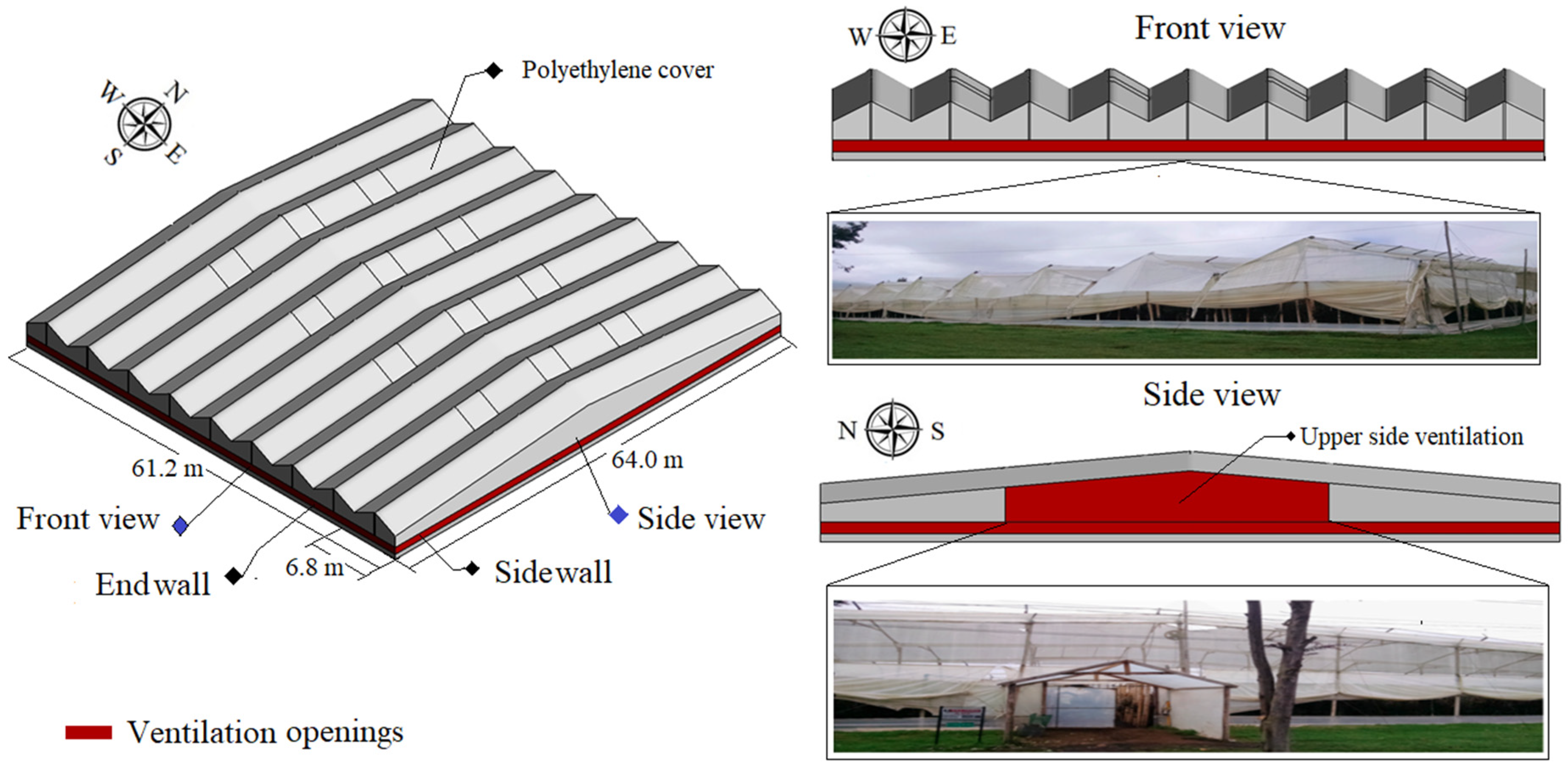
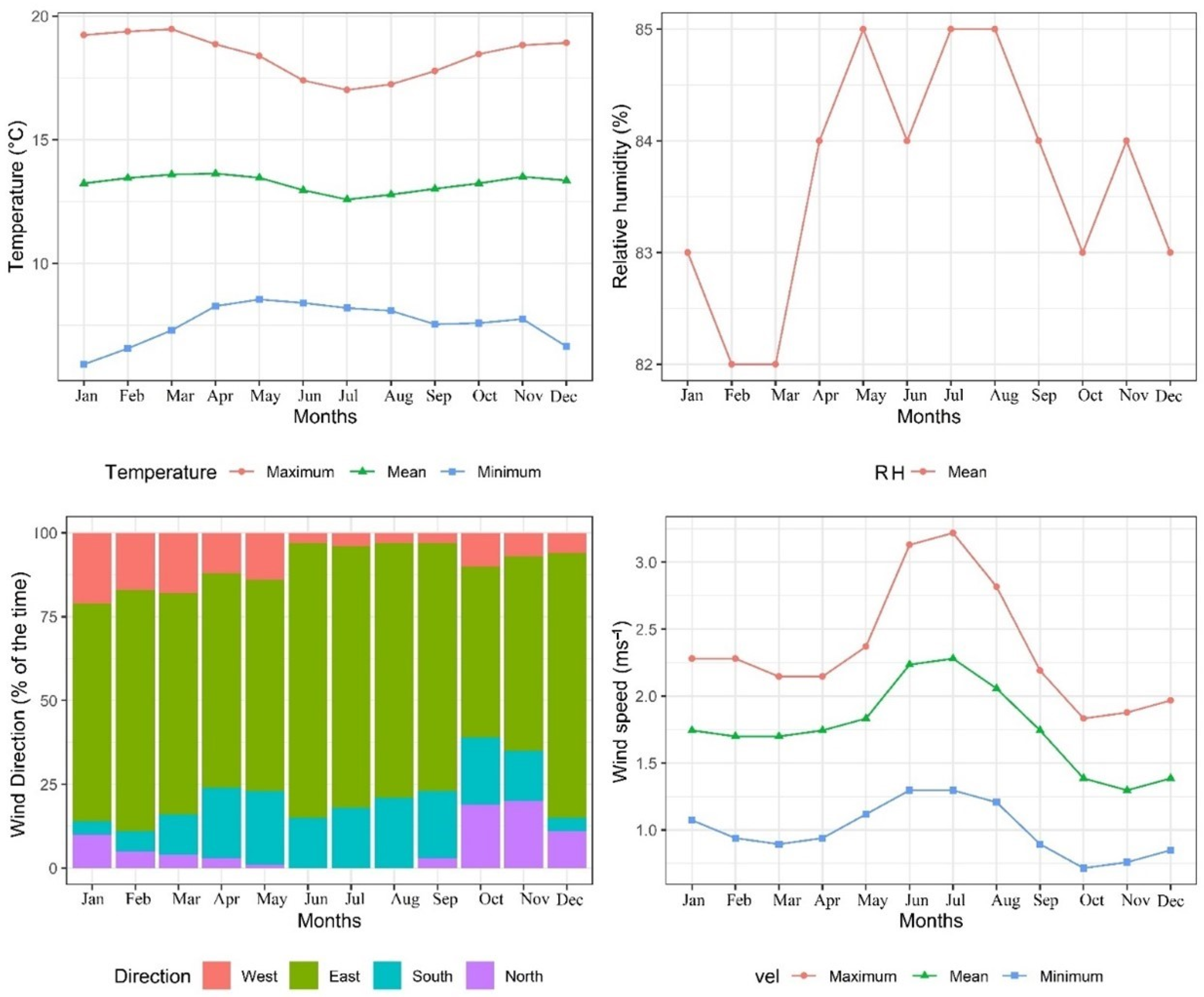
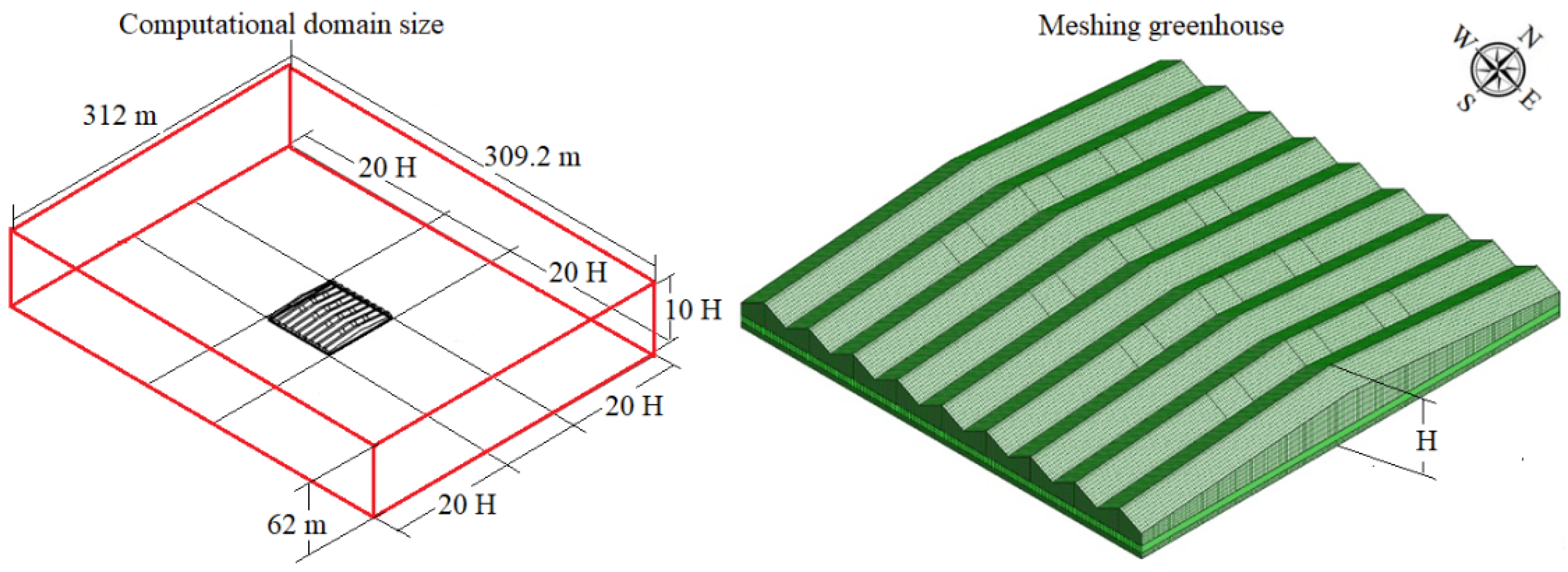

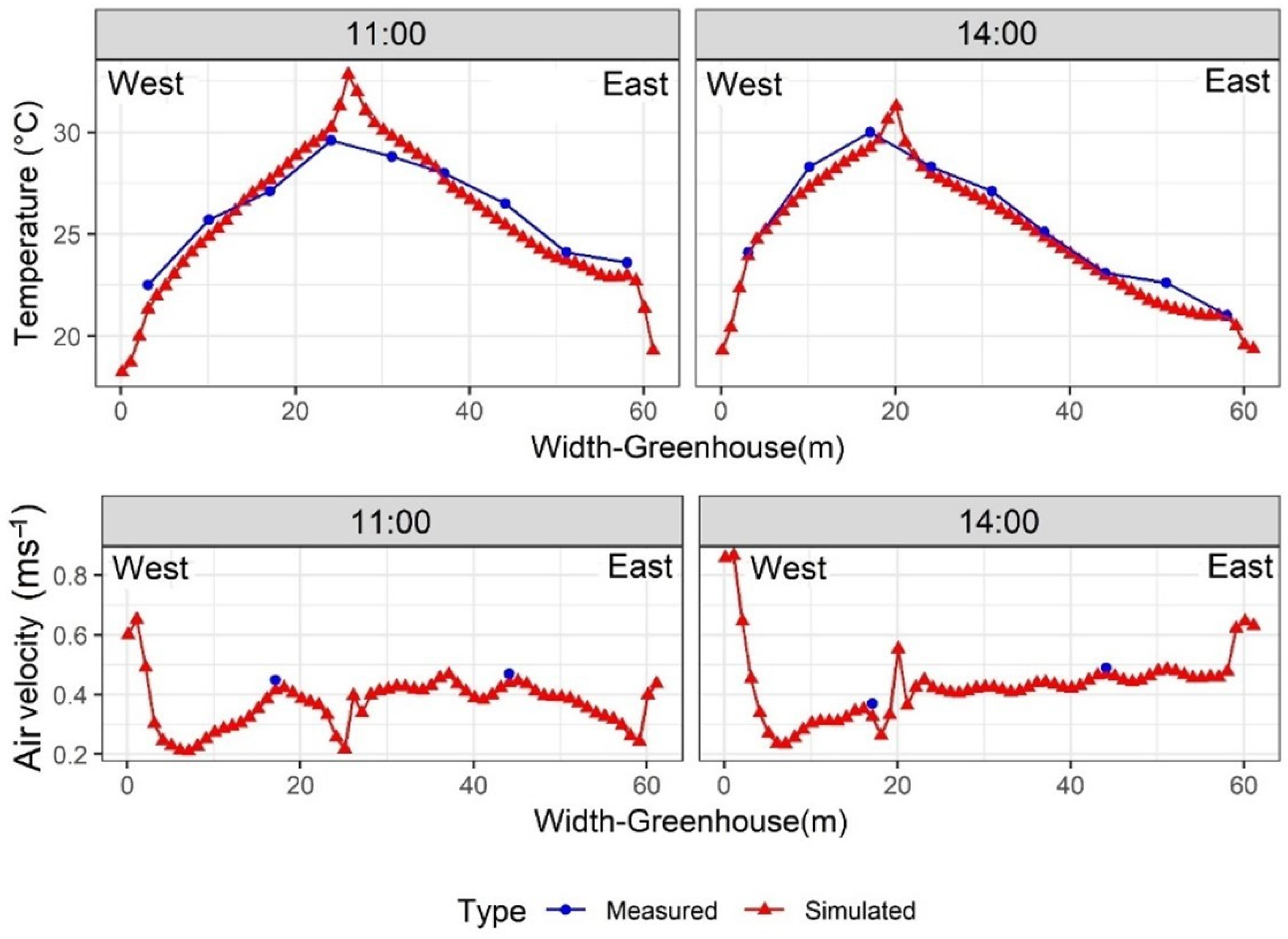

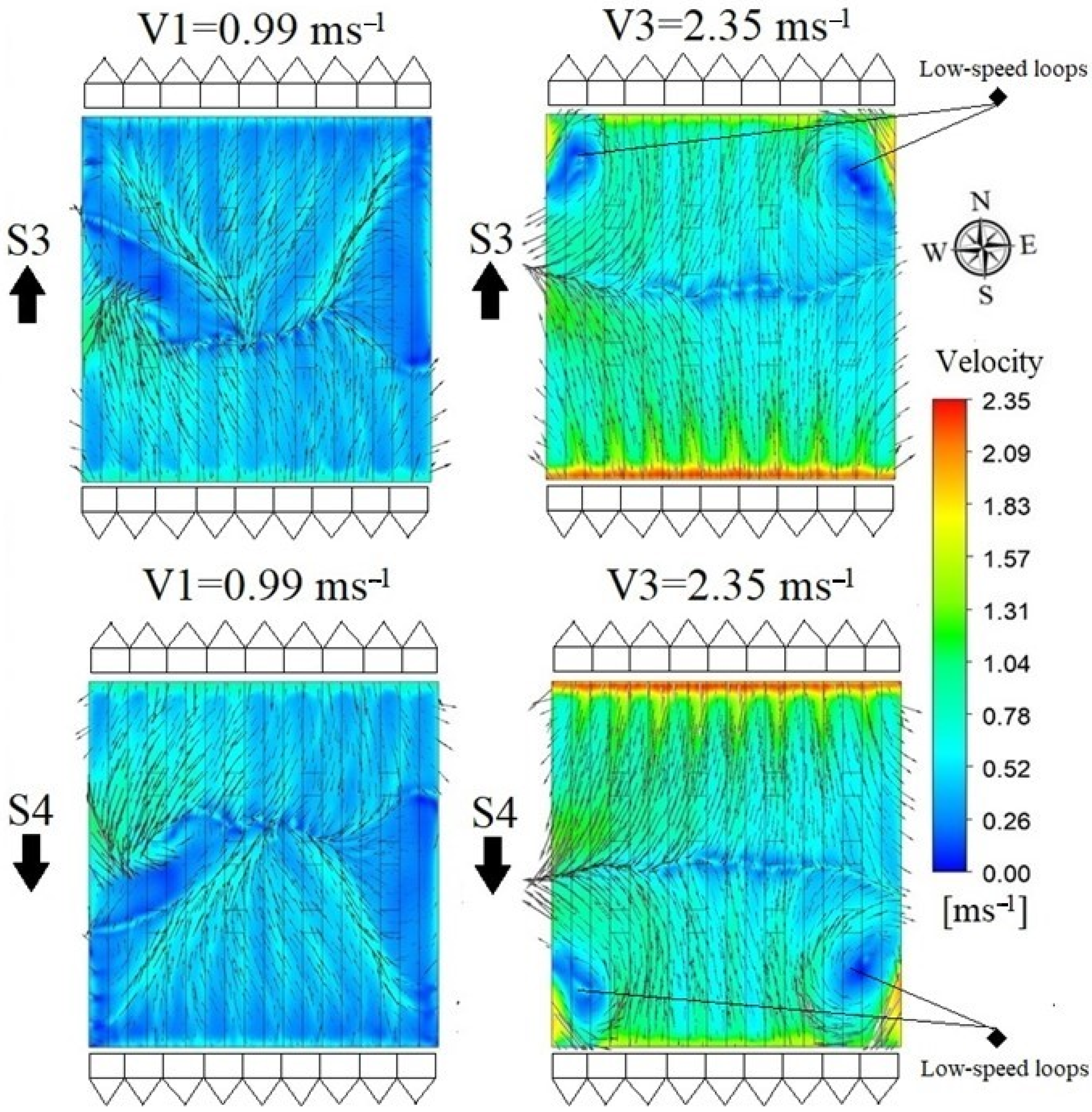

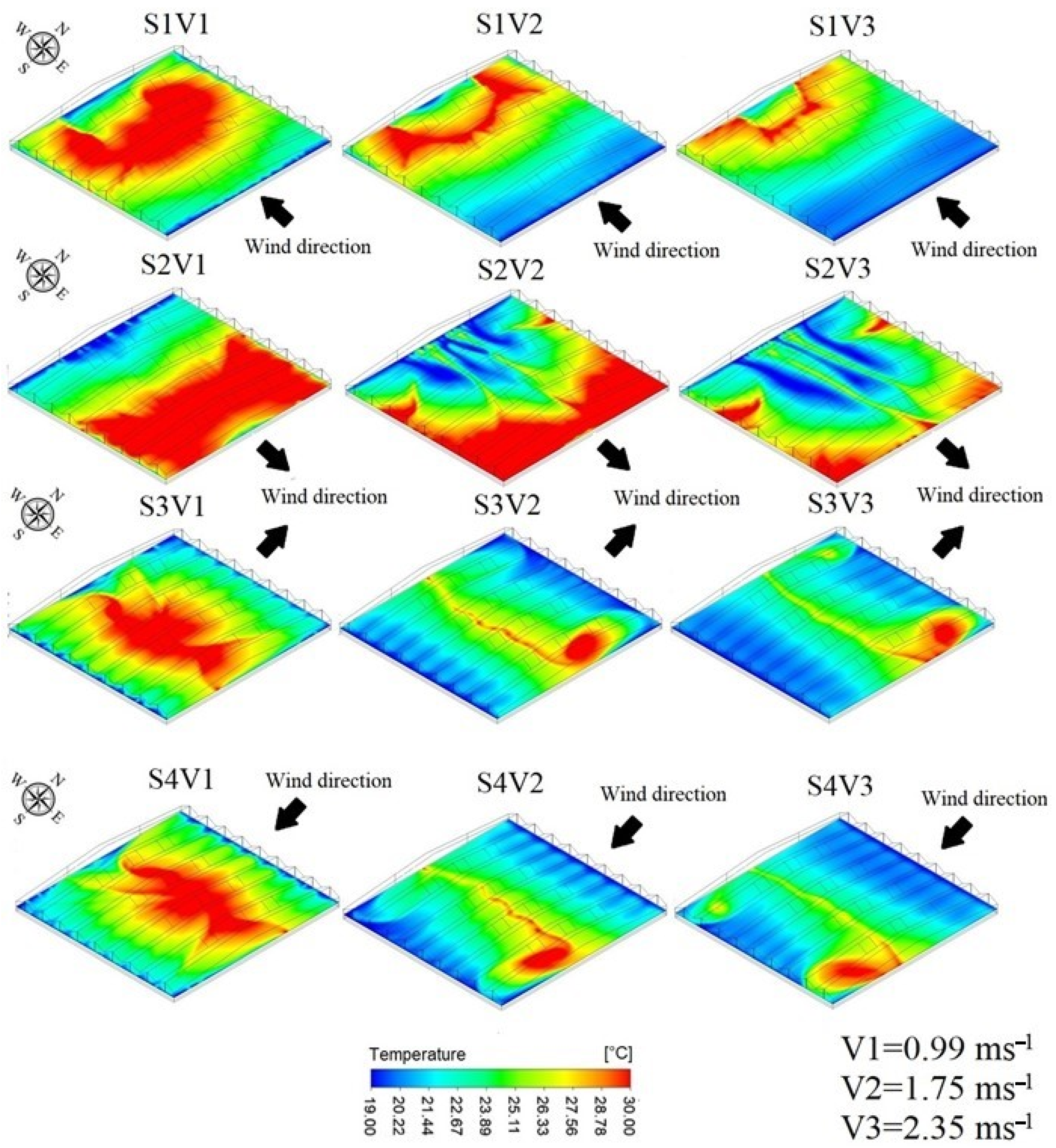
| Property | Soil | Air | Cover Greenhouse |
|---|---|---|---|
| Density (ρ, kg m−3) | 1.300 | 0.910 | 923 |
| Thermal conductivity (k, W m−1 K−1) | 1.3 | 0.0242 | 0.4 |
| Specific heat (Cp, J K−1 kg−1) | 800 | 1006.43 | 2300 |
| Absorptivity | 0.90 | 0.19 | 0.06 |
| Scattering coefficient | −15 | 0 | 0 |
| Refractive index | 1.92 | 1 | 1.53 |
| Emissivity | 0.95 | 0.9 | 0.7 |
| Hour | Temperature ± SD (°C) | Relative Humidity ± SD (%) | Solar Radiation ± SD (Wm−2) | Wind Speed ± SD (ms−1) | Wind Direction |
|---|---|---|---|---|---|
| 11:00 | 17.3 1.2 | 80.9 4.6 | 563 45.2 | 0.90 0.23 | E |
| 14:00 | 18.3 1.4 | 78.6 3.5 | 632 78.2 | 1.48 0.38 | E |
| Scenario | Temperature (°C) | Relative Humidity (%) | Solar Radiation (Wm−2) | Wind Speed (ms−1) | Wind Direction * |
|---|---|---|---|---|---|
| S1V1 | 18.45 | 83.6 | 763 | 0.99 | W |
| S1V2 | 18.45 | 83.6 | 763 | 1.75 | W |
| S1V3 | 18.45 | 83.6 | 763 | 2.35 | W |
| S2V1 | 18.45 | 83.6 | 763 | 0.99 | E |
| S2V2 | 18.45 | 83.6 | 763 | 1.75 | E |
| S2V3 | 18.45 | 83.6 | 763 | 2.35 | E |
| S3V1 | 18.45 | 83.6 | 763 | 0.99 | N |
| S3V2 | 18.45 | 83.6 | 763 | 1.75 | N |
| S3V3 | 18.45 | 83.6 | 763 | 2.35 | N |
| S4V1 | 18.45 | 83.6 | 763 | 0.99 | S |
| S4V2 | 18.45 | 83.6 | 763 | 1.75 | S |
| S4V3 | 18.45 | 83.6 | 763 | 2.35 | S |
| Scenario | Mean Air Velocity ± SD (ms−1) | Minimum Air Velocity (ms−1) | Maximum Air Velocity (ms−1) |
|---|---|---|---|
| S1V1 | 0.38 ± 0.10 | 0.06 | 0.87 |
| S1V2 | 0.45 ± 0.18 | 0.07 | 1.36 |
| S1V3 | 0.54 ± 0.23 | 0.06 | 1.75 |
| S2V1 | 0.36 ± 0.13 | 0.05 | 0.93 |
| S2V2 | 0.59 ± 0.20 | 0.09 | 1.40 |
| S2V3 | 0.68 ± 0.30 | 0.09 | 1.76 |
| S3V1 | 0.38 ± 0.14 | 0.05 | 1.03 |
| S3V2 | 0.57 ± 0.20 | 0.05 | 1.50 |
| S3V3 | 0.69 ± 0.27 | 0.04 | 2.06 |
| S4V1 | 0.39 ± 0.15 | 0.02 | 1.05 |
| S4V2 | 0.58 ± 0.21 | 0.04 | 1.56 |
| S4V3 | 0.72 ± 0.28 | 0.04 | 2.12 |
| Scenario | Tm ± SD (°C) | Tmax (°C) | Tmin (°C) | ΔTinside (°C) | ΔT (°C) |
|---|---|---|---|---|---|
| S1V1 | 26.8 ± 3.9 | 36.0 | 18.9 | 17.1 | 8.4 |
| S1V2 | 24.6 ± 3.6 | 33.5 | 19.0 | 14.5 | 6.2 |
| S1V3 | 23.6 ± 3.5 | 32.3 | 19.1 | 13.3 | 5.2 |
| S2V1 | 27.3 ± 4.0 | 37.2 | 18.6 | 18.6 | 8.8 |
| S2V2 | 25.7 ± 4.1 | 35.2 | 18.6 | 16.6 | 7.3 |
| S2V3 | 24.2 ± 3.4 | 34.4 | 18.6 | 15.8 | 5.8 |
| S3V1 | 26.0 ± 3.1 | 35.6 | 18.8 | 16.8 | 7.5 |
| S3V2 | 23.4 ± 2.6 | 32.5 | 18.8 | 13.7 | 4.9 |
| S3V3 | 22.7 ± 2.5 | 32.5 | 19.0 | 13.5 | 4.2 |
| S4V1 | 25.9 ± 3.0 | 34.8 | 18.8 | 16.0 | 7.5 |
| S4V2 | 23.3 ± 2.7 | 32.8 | 18.7 | 14.1 | 4.8 |
| S4V3 | 22.6 ± 2.6 | 32.1 | 19.0 | 13.1 | 4.2 |
Publisher’s Note: MDPI stays neutral with regard to jurisdictional claims in published maps and institutional affiliations. |
© 2021 by the authors. Licensee MDPI, Basel, Switzerland. This article is an open access article distributed under the terms and conditions of the Creative Commons Attribution (CC BY) license (https://creativecommons.org/licenses/by/4.0/).
Share and Cite
Villagrán, E.; Flores-Velazquez, J.; Bojacá, C.; Akrami, M. Evaluation of the Microclimate in a Traditional Colombian Greenhouse Used for Cut Flower Production. Agronomy 2021, 11, 1330. https://doi.org/10.3390/agronomy11071330
Villagrán E, Flores-Velazquez J, Bojacá C, Akrami M. Evaluation of the Microclimate in a Traditional Colombian Greenhouse Used for Cut Flower Production. Agronomy. 2021; 11(7):1330. https://doi.org/10.3390/agronomy11071330
Chicago/Turabian StyleVillagrán, Edwin, Jorge Flores-Velazquez, Carlos Bojacá, and Mohammad Akrami. 2021. "Evaluation of the Microclimate in a Traditional Colombian Greenhouse Used for Cut Flower Production" Agronomy 11, no. 7: 1330. https://doi.org/10.3390/agronomy11071330
APA StyleVillagrán, E., Flores-Velazquez, J., Bojacá, C., & Akrami, M. (2021). Evaluation of the Microclimate in a Traditional Colombian Greenhouse Used for Cut Flower Production. Agronomy, 11(7), 1330. https://doi.org/10.3390/agronomy11071330









